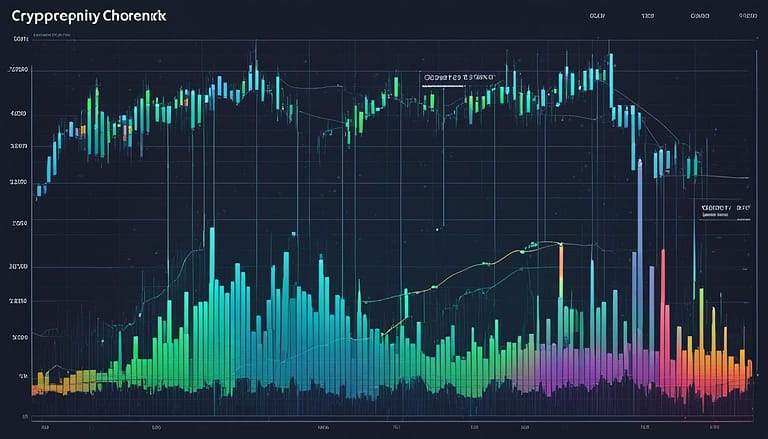Insights into the Global Cryptocurrency Market
The terrain of Cryptocurrency investment is constantly shifting, presenting a collage of challenges and opportunities for the savvy investor. As part of a daring and forward-thinking financial epoch, individuals and institutions alike are seeking refined Investment Insights into what this digital currency horizon entails. The Global Market for these innovative assets has not only burgeoned but continues to redefine the parameters of modern financial exchange and Market Analysis methodologies.
In their epitome of fluidity and with a valuation that has leapt to staggering heights, cryptocurrencies have fashioned an ecosystem teeming with both traditional investors and new market entrants. This progression affirms a future where the digital currency market is not an adjunct, but a significant protagonist within the global economic theatre.
Key Takeaways
- Global cryptocurrency market estimated at USD 910.3 million as of 2021, with a projected rise to USD 1,902.5 million by 2028.
- Stable CAGR of 11.1% from 2021 to 2028 signaling a robust and expanding digital currency economy.
- Technological leaps in blockchain fostering efficiency and security, attracting major institutional engagement.
- COVID-19 pandemic precipitating both market shock and an uptick in cryptocurrency investment interest.
- Critical partnerships, including that of Qtum Chain Foundation with AWS China, reflecting growing confidence in cryptocurrency viability.
Exploring the Size and Growth of the Global Cryptocurrency Market
The global cryptocurrency market has been on a trajectory of unprecedented expansion, marking significant milestones in both Market Size and Market Growth. This growth is not just a fleeting trend but a robust signal of an evolving financial paradigm shaped by technology and innovative investment strategies, as evidenced by notable increases in market value and the CAGR reflective of this burgeoning sector’s potential.
The Market Value Evolution from 2021 to 2028
From a valuation standpoint, the cryptocurrency market has seen a remarkable swell, particularly highlighted by a 10.0% escalation in 2020. This growth rate notably outpaced the years leading up to it, signifying a pivotal shift in the adoption and normalization of digital currencies. With the forward momentum being sustained, projections indicate that by 2028, the market is poised to almost double in size – a testament to the unyielding market expansion and the robustness of the asset class amidst a rapidly digitalizing economy.
Factors Contributing to the Market Expansion
- Distributed ledger technology introducing efficiencies in transactions and security.
- Increasing venture capital injections into digital asset firms and blockchain startups.
- Consistent consumer interest in cryptocurrencies, with Bitcoin and Litecoin leading the charge.
- An evolving regulatory landscape that is starting to embrace, rather than stifle, digital currencies.
These drivers, alongside others, have laid the groundwork for a flourishing digital economy where cryptocurrencies are at the forefront of financial innovation.
Forecasting the Continued Rise in CAGR
The Compounded Annual Growth Rate (CAGR) has become a beacon indicating the vigour and viability of the cryptocurrency market. Analysts predict that recovery to pre-pandemic market conditions, along with continued technological advancements and investor engagement, will facilitate a sustained upward trend in CAGR. This optimism, backed by a robust historical growth trajectory, paves the way for digital currencies to make an even more indelible mark on the global market landscape.
Technological Innovations Powering Cryptocurrency Advances
The emergence of blockchain technology has been a game-changer in the realm of cryptocurrency mining and digital transactions, setting a new standard for innovation and security. As the world continues to recognize the transformative potential of this technology, investments have surged, sparking a renewed focus on its application within the financial sector and beyond.
The heart of this technological revolution lies in blockchain’s ability to offer transparent, immutable, and secure transaction records – characteristics that are crucial for the trustless environment of cryptocurrencies. Consequently, there has been a notable shift towards leveraging the power of blockchain to enhance various facets of cryptocurrency mining, from increasing transaction speeds to enhancing security protocols.
Companies across the globe are not just passively observing these changes but actively engaging with them through strategic partnerships and investments. These collaborations are not merely for the sake of joining the bandwagon; they represent calculated endeavours to harness innovation for superior market positioning, customer experience, and operational excellence in the rapidly evolving landscape of digital finance.
- The refinement of smart contracts, self-executing contracts with the terms of the agreement directly written into code, has allowed for more complex and reliable applications of blockchain technology.
- Advances in consensus algorithms, such as Proof of Stake (PoS), have promised a more energy-efficient approach to cryptocurrency mining as compared to the traditional Proof of Work (PoW) system.
- Development of Layer 2 scaling solutions, such as the Lightning Network, work to address inherent limitations in blockchain scalability, making transactions faster and cheaper than ever before.
Indeed, the integration of innovative technologies with digital assets like Bitcoin is poised to not only propel market growth but to unlock a myriad of new services for users, reshaping the financial landscape in profound and irreversible ways.
Innovation in blockchain technology is not just reshaping the world of cryptocurrency; it is rewriting the rules of digital engagement and transaction security – defining a new era for the digital economy.
Investment Insights: Navigating the Waters of a Volatile Market
Understanding the economic impact, investment strategies, and inherent cryptocurrency volatility is crucial for investors looking to navigate the complex waters of the digital currency marketplace. With the rapid evolution of this sector, assessing the market’s temperamental swings in response to global economic events can equip investors with valuable foresight into potential risks and rewards.
Analysis of the Market’s Reaction to Economic Events
Market trends indicate that cryptocurrencies have historically shown a sensitive response to international economic events. Events such as policy changes by central banks or fluctuations in traditional stock markets can lead to significant volatility in cryptocurrency markets. For instance, Bitcoin’s reaction to the S&P Index’s dip was swift and significant, serving as a clear demonstration of this correlation.
Understanding the Digital Investment Landscape
The investment landscape within the digital currency realm has been transformative, characterized by the innovative use of blockchain technology and the entry of a new cohort of investors. As traditional investment vehicles encounter stagnation, cryptocurrencies offer an alternative with the potential for high returns, albeit at a greater risk due to their volatility.
The Role of Venture Capital in Cryptocurrency Growth
Venture capital has played a pivotal role in fostering growth and innovation within the cryptocurrency sector. Despite the challenges following the ICO market downturn, venture capital interest has been a testament to the sector’s resilience and ongoing potential. These investments have not only provided financial backing but have also been critical in legitimizing and strengthening the economic impact of digital currencies.
Global Cryptocurrency Market Drivers and Barriers
The cryptocurrency ecosystem is constantly influenced by a complex set of market dynamics, which include both drivers that propel growth and barriers that pose challenges. While digital assets have shown a remarkable capacity to withstand economic instability, the pathway is not without its obstacles.
Identifying What Fuels Market Demand
The ever-increasing interest in cryptocurrencies has been significantly driven by their inherent characteristics. These digital assets offer an alternative during times of financial crisis, where traditional banking systems falter, thus demonstrating resilience and attracting investors worldwide. Moreover, regions fraught with economic instability look towards these digital currencies for financial inclusion and stability. Here’s an overview of the key market demand drivers:
- Decentralization offering user autonomy
- Lower transaction fees compared to traditional finance
- Increased privacy and security through blockchain technology
- Accessibility for underbanked or unbanked populations
Examining Challenges and Restraints
Despite the promising benefits of cryptocurrencies, several barriers hinder widespread adoption. Among the foremost concerns are the regulatory uncertainties that loom over digital assets. A lack of clear guidelines can stifle innovation and deter potential investors. Additionally, the potential for misuse in illicit activities remains a pressing issue that continues to cast a shadow over the market’s legitimacy.
| Challenge | Implications | Potential Solutions |
|---|---|---|
| Regulatory Uncertainty | Stymies market expansion and investor confidence | Establishment of universal regulatory standards |
| Misuse for Illicit Activities | Undermines legitimacy and attracts scrutiny | Advanced monitoring and law enforcement collaboration |
| Cybersecurity Risks | Threatens asset security and user trust | Implementation of cutting-edge security protocols |
Rising Popularity of Digital Currencies Amidst Global Challenges
Despite the challenges facing the market, digital currencies continue to rise in popularity. Their unique allure amidst global economic instability points towards a paradigm shift in how we perceive money and manage transactions. The intrinsic properties of cryptographic security, coupled with the potential for high returns, keep attracting diverse cohorts of investors—from seasoned traders to curious novices.
Whether it’s used as a hedge against inflation during market turmoil or as a means to enable frictionless international transactions, the role of digital assets within the global economy is proving to be both transformative and enduring. As such, the market’s complexities—skilfully navigated—may herald a new era of financial sovereignty and innovation.
The Impact of COVID-19 on Cryptocurrency Markets
The global pandemic has had significant implications across financial sectors, with the cryptocurrency markets being no exception. The COVID-19 impact has been a major catalyst for market fluctuations and consequential investment shifts, presenting both challenges and opportunities within the crypto sphere.
During the initial stages of the pandemic, the uncertainty led to severe volatility, causing prices of leading digital assets like Bitcoin and Ethereum to sway unpredictably. This period was marked by an investor struggle to navigate the new economic landscape. However, following the market dip, cryptocurrencies managed to rally, showcasing resilience and the potential for serving as a digital safe haven during times of economic strife.
Central banks across the globe responded with measures such as liquidity injections and lowering interest rates in an attempt to stabilize economies. These actions have inadvertently painted a positive outlook for cryptocurrencies by reducing the appeal of traditional interest-bearing assets and making the zero-to-low interest yield of cryptocurrencies comparably more attractive.
Moreover, with traditional investments reeling under the pressure of the economic downturn, investors began seeking alternative assets to hedge against inflation, leading to an amplified interest in cryptocurrencies. Let’s look at how investment patterns have evolved during this period:
| Period | Investment Trend | Market Response |
|---|---|---|
| Q1-Q2 2020 | Initial sell-off due to pandemic uncertainty | Sharp declines followed by a strong recovery |
| Q3-Q4 2020 | Growing investment as a hedge against inflation | Steady growth and increased institutional interest |
| 2021 Onwards | Continued diversification into crypto | Gradual ascent with interspersed volatility |
It is clear that as the world adjusts to a post-pandemic reality, the behavior of investors towards cryptocurrencies will likely continue to evolve. The resilience of the crypto market amidst these trying times presents a unique narrative of its role in the years to come, potentially altering the fabric of global financial systems.
Adoption Trends: Cryptocurrency Goes Mainstream
The trajectory of cryptocurrencies has seen a remarkable shift towards broad-based legitimacy and acceptance. Spearheaded by the involvement of heavyweight Institutional Investors and buoyed by evolving Consumer Trends, the landscape is witnessing an inflection point earmarked by Mainstream Adoption. We now stand at a juncture where digital currencies are reshaping financial conventions and sparking a recalibration of investment strategies worldwide.
The Rise of Institutional Investment in Cryptocurrencies
Institutional engagement in the cryptocurrency domain has transitioned from cautious intrigue to strategic action. Investment funds, pension plans, and other institutional players are not only dipping their toes but diving in to harness the potential of these digital assets. This entry of institutional capital is a testimony to the growing confidence in cryptocurrency’s value proposition and its recognized role in diversification and potential returns within investment portfolios.
Technological Giants Entering the Crypto Space
Industry stalwarts from the tech sector are making calculated forays into the cryptocurrency sphere, cementing its status as a mainstream financial instrument. These are not whimsical ventures but rather intentional integrations aimed at leveraging blockchain’s robustness and cryptocurrencies’ transactional benefits. The clout these tech behemoths carry inevitably steers market sentiment, fortifying the legitimacy and practicality of cryptocurrencies.
Shifts in Consumer Attitudes Towards Digital Currencies
Ground-level shifts are equally compelling, with everyday consumers becoming progressively attuned to the nuances and advantages offered by digital currencies. This change in sentiment is catalyzed by consumers’ heightened demand for autonomy, transparency, and efficiency in transactions—all hallmarks of the blockchain technology underpinning cryptocurrencies.
| Year | Institutional Investors | Technology Companies | Consumer Adoption Level |
|---|---|---|---|
| 2017 | Early Interest | Exploratory | Low Awareness |
| 2019 | Active Engagement | Development of New Platforms | Growing Interest |
| 2021 | Strategic Investment | Integration into Services | Solidifying Trust |
| 2023 | Diversified Portfolios | Market Expansion | Mainstream Usage |
The combined momentum from institutional investment surges, technological adoption by industry giants, and shifting consumer attitudes offers a compelling narrative for the mainstream adoption of cryptocurrencies. As these elements converge, they forge a pathway for cryptocurrencies towards becoming an indelible part of the global financial ecosystem.
Regulatory Influences on the Global Cryptocurrency Market
As the cryptocurrency market continues to grow, the importance of developing robust cryptocurrency regulation increases. Stakeholders are seeking clarity in the legal framework that governs these digital assets, which, in turn, shapes the market and influences investor confidence. In particular, the industry is closely monitoring the evolving role of Central Bank Digital Currency (CBDC), which represents the intersection of innovation and regulatory oversight in the financial world.
Understanding the Legal Landscape
The legal landscape of digital currencies presents a complex and varied picture across different jurisdictions. Amidst the burgeoning market, regulators are challenged to implement frameworks that secure investor protection without curtailing the potential for technological advancements and economic benefits that cryptocurrencies can offer.
Central Banks and Digital Currencies: An Evolving Relationship
Central banks around the globe are carefully examining the impact of cryptocurrencies on financial stability and monetary policy. The concept of Central Bank Digital Currency is starting to gain traction as more countries explore the possibility of issuing their own digital currency, potentially transforming the current financial architecture and introducing a new era of government-backed digital money.
The Challenges of International Cryptocurrency Legislation
The decentralized and borderless nature of cryptocurrencies poses significant challenges for international cryptocurrency regulation. Harmonizing legal frameworks across different nations remains a daunting task, yet it is crucial for controlling potential risks such as money laundering, tax evasion, and fraud, while fostering a nurturing environment for lawful innovation and development.
Market Analysis: Cryptocurrency as a Disruptive Economic Force
The rise of cryptocurrency has prompted in-depth economic analysis as industry experts attempt to quantify its impact on traditional financial structures. Indeed, market disruption is evident as digital currencies leverage the advantages of distributed ledger technology to offer innovative solutions to financial market processes.
One of the most profound changes has been the proliferation of crypto trading platforms, which have democratized access to digital assets, allowing individuals and institutions alike to participate in cryptocurrency markets. Their user-friendly interfaces, combined with low transaction fees, have revolutionized how traders and investors approach the asset class.
The flexibility and volatility of digital currencies have cast them not only as an investment option but as a versatile tool for diversifying portfolios and managing risks. This adaptability is crucial in times of economic uncertainty, underlining the strategic edge cryptocurrencies provide to those who harness them effectively.
Cryptocurrencies rewire traditional market operations, and are at the forefront of a paradigm shift in global economic activities.
| Traditional Financial Systems | Cryptocurrency Markets |
|---|---|
| Regulated by central authorities | Decentralized and autonomous |
| Geographical transaction barriers | Borderless and global |
| Standard banking hours | 24/7 market access |
| Slower transaction speeds | Near-instantaneous transactions |
| Limited data transparency | Transparent blockchain ledger |
In conclusion, as the global financial ecosystem evolves, so too does the realm of digital currencies. The emerging economic analysis highlights their role in prompting both opportunities and challenges within the sphere of market disruption. Bearing witness to this evolution are the crypto trading platforms that stand as pillars of a new economic era.
Security in Cryptocurrency: Addressing the Risks and Solutions
In the digital age where cryptocurrency has become a prominent financial asset, understanding the nuances of cryptocurrency security is imperative for investors and market participants. Discussions surrounding cybersecurity threats and the integration of blockchain solutions are at the forefront of this financial revolution, guiding the industry towards safer transactions and trust in digital assets.
Preventing Misuse: Measures Against Illegal Activities
Regulatory bodies worldwide are intensifying their efforts to prevent the misuse of cryptocurrencies for illicit purposes. Tightened KYC (Know Your Customer) procedures, enhanced monitoring systems, and coordinated international regulatory efforts form the foundation of a more secure crypto space.
Cybersecurity Threats and the Protection of Digital Assets
Cybersecurity threats remain a significant concern in the world of virtual currencies. Ranging from phishing scams to exchange hacks, these challenges necessitate a multi-faceted approach to protect digital assets. Companies in the space are increasingly adopting advanced encryption protocols and employing cybersecurity experts to fortify their defenses against these digital menaces.
The Role of Blockchain in Enhancing Transactional Security
Blockchain remains a game-changer, providing transparent and immutable transaction records. Distributed ledger technology not only enhances the security of digital transactions but also empowers users to verify and audit transactions independently.
| Security Challenge | Impact on Cryptocurrency | Blockchain Solution |
|---|---|---|
| Illicit Transaction Tracking | Increases risk of fraud and financial crime | Immutable ledger for transparent transaction history |
| Exchange Security Breach | Leads to loss of funds and investor trust | Decentralized exchanges with enhanced user security |
| Wallet Security Compromise | Threatens personal asset security | Smart contracts for automated and secure transactions |
| Phishing Attacks | Targets user credentials and assets | Multi-factor authentication and user-awareness programs |
Confronting and addressing these security issues with decisive and informed responses will continue to be a primary focus for stakeholders. As blockchain technology and security measures evolve, the cryptocurrency ecosystem is poised to become a more secure and reliable field for financial activities.
Conclusion
As we stand on the cusp of a new chapter in the financial realm, the future outlook of the global cryptocurrency market emanates a promising and dynamic forecast. Driven primarily by relentless technological advancements, the landscape of digital currencies continues to undergo a remarkable cryptocurrency evolution, overcoming the barriers of yesterday and paving new avenues for tomorrow. Despite the ever-looming shadow of security concerns and economic tremors, the industry’s resilience and adaptability hint towards a robust growth trajectory with impressive market projections. As the tapestry of this market is delicately woven with ongoing innovation and strategic regulatory efforts, its potential extends far beyond mere speculation.
Eyeing the horizon, it is evident that both institutional and individual embracement of cryptocurrencies is not a fleeting trend but a formidable shift in the global economic fabric. The surge of interest and investment from established financial entities and pioneering technology conglomerates reinforces the currency’s legitimacy and foreshadows a significant expansion of its role within the economy. As we project forward, the compelling amalgamation of increasing adoption rates and regulatory maturation suggests that digital currencies will indelibly imprint their presence on international trade, investment strategies, and payment systems.
In summary, the journey of the cryptocurrency market is far from its conclusion; it is, in fact, accelerating towards a future rich with innovation and integration. With attentive observation and informed foresight, stakeholders can navigate this exhilarating domain, harnessing its potential while remaining vigilant of the challenges that come with any financial frontier. For Canada, and indeed the world over, the essence of cryptocurrencies represents not merely a digital asset but a revolution in the making, one that could redefine the economic narrative in the years to come.










